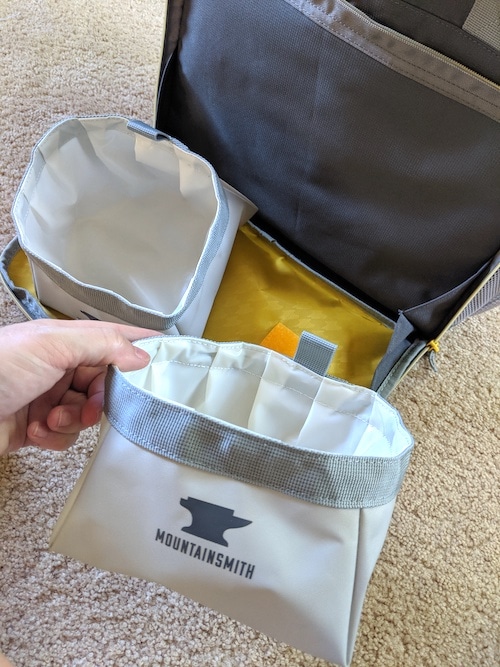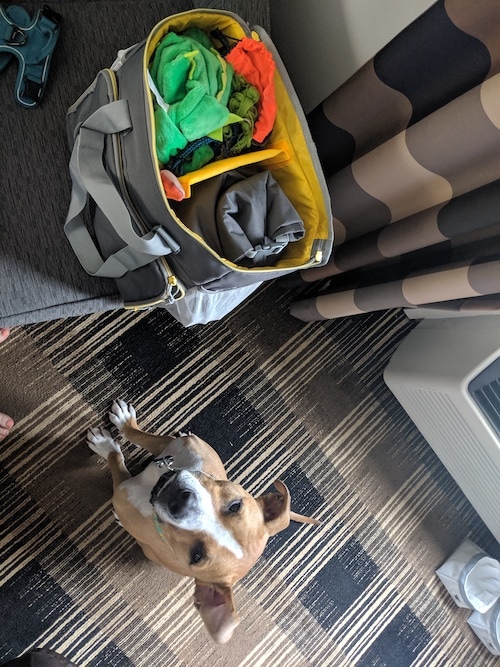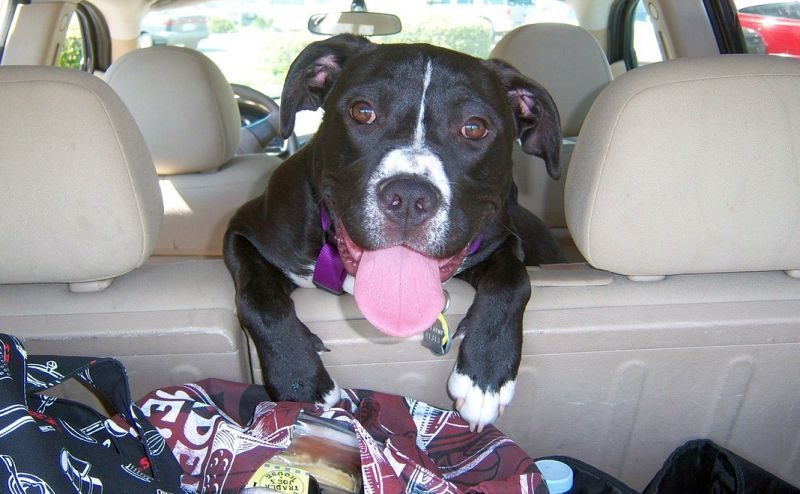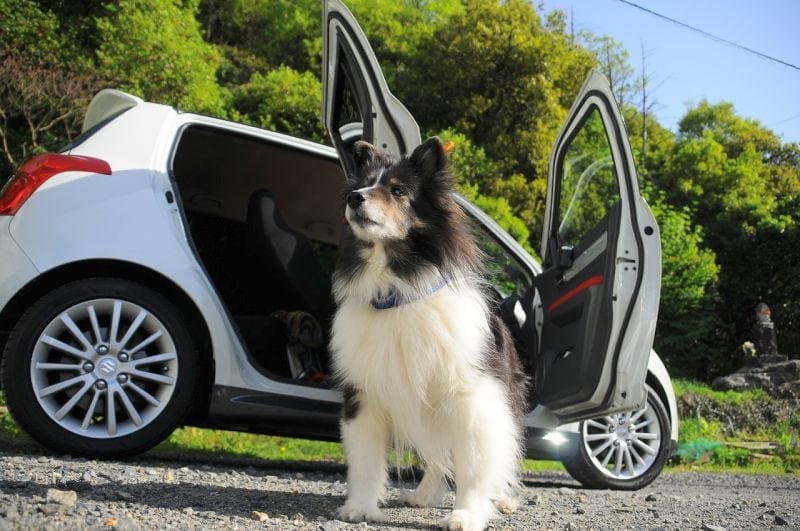Whether you’re taking a day trip to the beach, visiting the in-laws during the holidays, or heading out on a full-fledged vacation, you simply must bring the family dog with you!
Unless, that is, your soul can withstand some seriously sad puppy dog eyes when you return.
But traveling with your pooch is a bit more complicated than traveling sans four-footer.
We’ll help you dog-loving families prep for those long road-trip with our collection of tips and tricks below. Whether you’re embarking on a full-on van life adventure with your dog or just doing a cross-country trip to visit family, these tips will be sure to help you keep your furry family member safe!
Temperature Safety
It is important to “triage” your dog’s needs when heading out on the open road. You have to think about her safety first, before moving on to her comfort and enjoyment.
Accordingly, one of the first things you’ll need to consider is the car’s climate.
Winter Travel with Dogs
Unless your road trip involves rolling across a frozen tundra with the top down, most dogs will stay warm enough during the ride.
As long as the interior car temperatures are in the mid-40s, most dogs should remain comfortable. Big, furry pooches will remain comfortable in temperatures 10 degrees or so lower than this.
You’ll obviously want to fit your little sweetie with a canine sweater if she needs one for crisp fall mornings, but just use common sense and read your pup’s body language.
If she’s shivering or remains in a heat-conserving curly-cue for long periods of time, you may want to bump up the heat.
However, you will want to use extra caution whenever you need to turn the car off and leave your pupper inside, such as while taking a dinner break. But even during these times, a warm blanket or two will usually suffice to keep your canine cozy for a short period of time.
Summer Travel with Dogs
It is incredibly important to keep the temperature in mind when traveling with your pooch during the summer.
This is not the time to take chances.
For the most part, your pooch will be fine when riding alongside you. As long as you’re comfortable and have the AC on, your canine will be chillin. The problems typically occur when you have to leave your pup alone in the car.
But there are even ways to keep your dog safe on those rare occasions in which you need to (briefly) leave your dog in the car.
Just check out our guide to safe summertime car travel with your dog, written by trainer, behavior consultant, and regular K9 of Mine contributor Kayla Fratt.
This article should be considered mandatory reading by all pet parents with an upcoming road trip, but here are a few of the most important points:
- Be sure to take extra precautions anytime the temperatures flirt with the 80-degree mark.
- High humidity levels can cause your pooch to overheat more quickly than she would during similar, but drier, conditions.
- Take your car’s color (including the interior) into consideration during summer travel. Small, dark-colored cars are the quickest to heat up (especially if they have dark interiors).
- Be sure that it is even legal to leave your car alone in a car in your state before doing so.
There are also a few products that may help keep your canine safe and comfortable in the car.
For example, a car windshield shade will help reflect the sun’s rays blasting your car. You can also get shades that will cover your car’s door windows. These are even helpful while you’re driving!
In fact, these types of shades are great whether you leave your dog in the car or not, as they’ll keep your car cooler whenever you leave it parked in the sun. Some especially dog-friendly cars have shades like these already built-in.
You can also use window gates to keep the car temperatures from climbing sky high. These gates allow you to roll down the window (partially), which will allow air to flow through the car.
However, our favorite must-have gadget for any road trip would have to be the Waggle Pet RV Temperature Monitor.
Waggle features a temperature monitoring device along with a companion app. The device is installed in your vehicle and tracks the temperature. If the temps get outside of the safety zone you set (whether due to heat or cold), you’ll get an alert notification on your phone via text or email! While it’s designed specifically with owners who are traveling via RV with a dog or cat, it works great for standard cars too!
This is a sponsored placement, in which an advertiser pays a fee to be featured in this article. Learn more
Of course, you can just skip all this hoopla and avoid leaving your dog alone in the car during the summer. That’s usually the safest, most cost-effective option when doable.

Crash Safety
It isn’t pleasant to think about, but you must ensure your family is as protected as possible in the event of an accident during your road trip – and that includes your four-footer.
For the two-legged members of your family, this is pretty simple: Just make sure that everyone wears a seatbelt or rides in an age-appropriate car seat. But it can be a little trickier to keep our dogs safe while riding in the car.
Essentially, you have three options:
- Use a dog crate designed for car use. This is the best option, as it’ll keep your pup the safest. However, car crates can take up quite a bit of space and some are pretty pricey.
- Fit your dog with a harness intended for use in the car. A car harness won’t provide the same level of protection that a crate will, but it will help keep your dog from being flung around the interior of the car in the event of an accident (apologies for the horrific imagery).
- Clip your dog in with a canine seatbelt. Canine seatbelts are another option that work in a similar fashion to car harnesses, except that you can use them with your dog’s existing harness.
Note that the vast majority of dog car harnesses, crates, and seatbelts are not crash tested. While they may keep your dog secure for minor fender benders, most common canine car-securing equipment won’t protect your dog in a true collision.
In our research, we were able to find car crates and harnesses that were successful crash-tested (and we detail them in the articles linked to above). However, there are no dog seatbelts that have been crash-tested.
All three of these options provide another benefit too: They’ll prevent your dog from wandering around the cabin and distracting you while you’re driving. This, in truth, is probably one of the most important reasons to secure your dog, as doggie distractions can easily cause a crash.
Keep the Family Together
Aside from health problems of car accidents, becoming separated from your pooch on a road trip is likely the worst thing that can happen.
Trying to relocate a runaway Rover at home is difficult enough – doing so in an unfamiliar place is unthinkably daunting (but not impossible).
This means you’ll want to do everything you can to prevent your dog from running off and be sure that you’ve taken steps to maximize the chances of finding your pup if she does manage to escape. Among other things, this means you’ll want to:
- Keep your dog leashed at all times. The only exceptions to this rule are when you are indoors or in an enclosed area, such as a fenced dog park. If your dog is a Houdini-like hound, you should also invest in an escape-proof dog harness.
- Make sure your dog is wearing ID tags with your current contact information. ID tags are an incredibly inexpensive and low-tech strategy that may drastically improve your chances of a happy reunion.
- Have your vet install a microchip implant on your dog. Microchip implants are tiny electronic devices that contain encoded data about your dog, which can help vets, shelters, or anyone else with a code reader to find you following a separation.
- Fit your dog with a GPS tracking collar. Microchip implants are very helpful, but they’re passive devices. You’ll simply have to wait by the phone and hope that your dog turns up at a vet or shelter. On the other hand, a GPS collar will allow you to hit the streets and track down your pup via a smartphone app.

Medical Issues
You’ll need to consider any health issues your dog has when getting ready to travel – you don’t want to end up dealing with a sick sidekick during the middle of your trip.
In fact, even if your dog is healthy as a horse, it’s a good idea to visit your vet right before your trip. This will help reduce the chances of a surprise illness popping up at an extremely inopportune time. For that matter, be sure that you have your vet’s phone number saved in your phone.
It’s also important to make sure you bring along a pet first-aid kit, loaded with your pet’s regular medications.
This includes not only the things she needs to deal with specific ailments (such as corticosteroids prescribed for itchy skin), but also routine medications, such as flea or heartworm medications.
You can put together a first-aid kit for your pet or you can just pick up a premade version. We explain the things you’ll need to include in your first aid kit and run down a few of the best premade versions on the market in our dog first-aid kit article.
There’s one more thing you may want to do before hitting the road with your pooch: Go ahead and locate a pet emergency room or two on your planned route.
I know this may seem like overkill, but in the minutes following some type of emergency, you’ll be glad you’ve already identified a few places you can get your pet emergency medical attention (and saved them on your phone).
Bathroom Breaks
For the most part, it should be pretty easy to take care of your dog’s bathroom needs during a road trip. Puppies will need to poop and pee every couple of hours, but most adult dogs can easily go 6 to 8 hours between bathroom breaks (and many can “hold it” even longer).
So, you don’t have to worry about stopping very often.
In fact, if you’re traveling with kids, they’ll certainly have to “go” more often than your pooch will, so walk your pupper when you stop at rest stops or fast food places to let the kids use the facilities.
Just be sure to exercise courtesy and common sense. This means keeping your pooch leashed and cleaning up behind her when she poops.
Food and Water on the Open Road
Keeping your dog fed and hydrated on the road won’t cause any serious problems, but there are a few things you’ll want to think about before you pack the pooch in the car.
- You can bring your pup’s normal food and water dishes on the road if you like, but there are some great travel-friendly options available. Many portable dog dishes are made from silicone or other lightweight materials, and some collapse to make them easier to store.
- Make sure you give your dog a chance to drink water every two or three hours. Use water fountains to fill his bowl when they’re available, but always carry a water bottle specifically for your pooch so you don’t ever have to worry about water availability.
- Try to feed your dog around the same time as you normally would. It’s a good idea to pamper your pet’s digestive tract a bit while traveling, to help prevent stomach upset. Feeding her at normal times is a good first step.
- Purchase smaller-than-normal cans of food, if your pup can’t polish off a whole can. Canned foods must be refrigerated once opened. This isn’t a problem for dogs who eat entire cans, but you’ll have to throw out any unfinished portion when traveling on the road (unless you bring along a cooler). So, if you normally buy 13-ounce cans, consider picking up a bunch of 6-ounce versions for your road trip.
- Split your dog’s kibble into pre-measured containers. You can bring your dog’s bag of dog food and a measuring cup on the road, but it’ll be much easier to simply portion out your dog’s meals beforehand. Try to use re-usable containers instead of single-use plastic bags, for the planet’s sake.
When it comes to keeping all your dog’s travel goodies stored in one convenient spot, we’re big fans of the K9 Cube from Mountainsmith!

The K9 Cube is a pretty nifty dog travel kit – the interior section offers two deep compartments for storing your dog’s food, toys, and other essentials. It comes will a waterproof lined storage bag that can safely hold your dog’s kibble and can easily be sealed to prevent mildew or bacteria from forming.

The cube also has two collapsable bowls to provide your pup with food and water during your hotel stays. The bowls can even be attached via velcro to the bag’s outer flap to keep the bowls stationary.

With tons of bonus mesh and zippered pockets, it can contain all your dog’s road-trip necessities (even when your dog is totally spoiled and has way too many road squeaky toys).

While Mountainsmith’s K9 Travel Cube ain’t cheap, it’s pretty awesome to have – especially if you do a lot of road tripping with your pooch!
Dealing with Boredom
“Are we there yet?”
Dogs can’t talk, but they’d probably repeat this phrase more often than your 7-year-old does during road trips if they could.
The problem is, you can’t just hand your dog a digital screen to keep her busy until you reach your destination. So, you’ll have to adopt other strategies.
Ideally, your dog will sleep for as much of the trip as possible.
So, try to let her exercise a bunch before heading out on the trip. You may even want to try to keep her awake a little longer than normal the night before.
But if your trip is longer than three or four hours, your pooch will undoubtedly be awake for part of the journey.
Some pooches will be content to stare out the window, but most will grow bored as the road trip carries on and on. Just make sure you have a few of your floof’s favorite toys on hand to help keep her occupied.
A simple chew toy may suffice for some dogs, but interactive toys will usually keep your dog’s interest for longer.
Assuming you can contain the mess (or don’t mind it), long-lasting chews and other hard-to-eat-but-edible things (such as peanut butter stuffed inside a KONG Toy) also deserve consideration.
Personally, whenever I need a little extra help keeping my pup busy, I pick up a brand-spanking new toy for her. The new-toy scent and unblemished surfaces usually drive her wild for a few hours, and keep her little brain humming.
Also, be sure to take a break every three to four hours to allow your dog to answer nature’s call and stretch her legs a bit.

Car Sickness
Dogs can get car sick just like people can.
I actually learned this firsthand when I was 4 years old, riding home in the car with my very first puppy. The poor pupper barfed all over me, which made for quite a welcome to the world of pets.
Car sickness is most commonly an issue for puppies and young dogs, as adults tend to outgrow it as they become more accustomed to riding in vehicles.
Nevertheless, some dogs continue to get queasy when riding in the car, so you’ll want to take whatever steps you can to prevent it from becoming a problem during your trip.
There are several simple things you can do, such as keeping the car a little cooler than normal or setting your dog up with a booster seat (we detail several other strategies for preventing vehicular vomiting in our canine car sickness article).
Try some of these strategies out before going on your trip. If they don’t work, your vet may be willing to prescribe medications that’ll help easy your dog’s motion sickness.
Keep in mind that many adult dogs experience car sickness more due to stress than to actual motion sickness. If your grown-up pooch is getting ill in the car, consider working on some strategies to reduce your dog’s car anxiety.
Canine-Accessible Accommodations
Ideally, you’ll be embarking (get it?) on a relatively short trip, you’ll likely arrive at your destination without having to stop overnight at a hotel.
But if your destination is hundreds of miles away, you’ll probably want to hole up in a hotel overnight to recuperate for the next day’s travel.
This isn’t usually difficult, but four-footers make hotel stays a bit more complicated.
For starters, you’ll need to find a hotel that accepts pets (as well as one that’ll accept your specific dog – some have size and breed restrictions). You’ll also want to investigate the fee-structures in place to avoid spending an arm and a leg for the right to sleep alongside your pupper.
In practice, you’ll often find it necessary to contact the specific hotel you intend to stay at to find out their policies. But, you can narrow things down and find out some of the basics by checking out our article on the best pet-friendly hotel chains.
Don’t worry – there are plenty of options available. Just be sure to follow the rules and avoid the temptation to sneak your pup in under the radar. That’ll just lead to you getting kicked out in the middle of the night when hotel management discovers your incognito canine.
If you’re looking for spots where you and your pup can chill out together and grab a bite, check out our full list of dog-friendly restaurant chains. Chances are you’ll find something pet-friendly somewhere on the road!

Check Out Your Destination Before Hitting the Road
Hopefully, you’re heading to a fun and fantastic destination. But whether you’re heading for the Big Apple or East Bumble, take a few minutes to check out the canine attractions in the area.
Many modern cities offer incredible dog-friendly amenities, ranging from off-leash parks to pet-friendly pubs and restaurants.
Some cities have canine daycare facilities that would be helpful when you must leave your pup for a while, and others have – this is no joke – dog lockers you can use to help keep your dog comfy, safe, and out of trouble while you’re shopping.
The point is, you’ll want to make the most of your trip and ensure your dog gets to take advantage of any special opportunities available.
It won’t take you long to do so, so spend 10 minutes Googling to get the low down. You can also check out our guide to the best dog-friendly vacation destinations as well as the 12 best dog-friendly cities if you’re heading to a mainstream metropolis.
Rover’s Road Trip Checklist
We’ve put together the checklist below to help during your next vehicular adventure with the dog.
We’d recommend saving or bookmarking this article on your phone as a handy reference, or even better, print out this list and slap it on the fridge.
- Collar
- Leash
- ID Tags with up-to-date contact info
- Food and water dishes
- Poop bags
- Bottled water
- Car harness or crate
- Any necessary medications (including monthly meds, such as heartworm or flea medicine)
- Dog bed
- Two to three favorite toys
- Dog-safe wet wipes (for messes)
- An old bath towel (for big messes)
- Any training tools (clickers, heel sticks, etc.) you plan on using during the trip
- Emergency contact info and resources

Don’t Forget to Keep Things Organized!
Chances are, you’re now sitting at your kitchen table with all of your dog’s necessities spread out in front of you. Just be sure that you keep things organized so that you can find tools and supplies when you need them.
The easiest way to do so is by picking up a premade dog travel bag. We love the Hilike Pet Travel Bag, as it comes with insulated food storage containers, silicone travel bowls, and a feeding mat, while still providing plenty storage space for some of your dog’s other gear.
But if you want to save some bucks, you can just use whatever travel bag or backpack you have stuffed in your closet.
The important thing is just that you keep all of your dog’s stuff together. This will make it easy to find things when you need them and help you avoid losing your pupper’s favorite toy or your backup leash when you need it.
***
Don’t be overwhelmed by all of the things you’ll want to address and take care of before heading on a road trip with your pooch.
There are certainly lots of things to do and think about, but once you’ve done so, you can be reasonably sure that you’ll avoid most problems and be prepared for any that do occur. And that will help ensure you and your floof have a fantastic time.
Have you ever taken a road trip with your dog? How did it go? What kinds of things do you do that we didn’t mention? Let us know your thoughts in the comments below!









No Comments